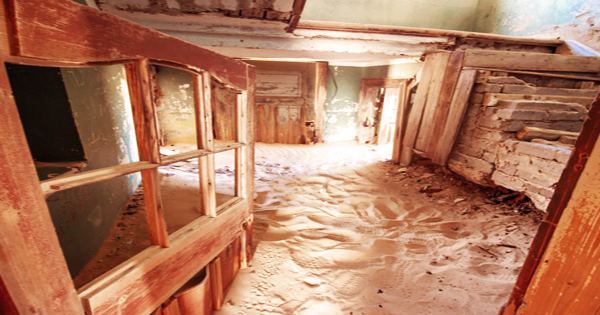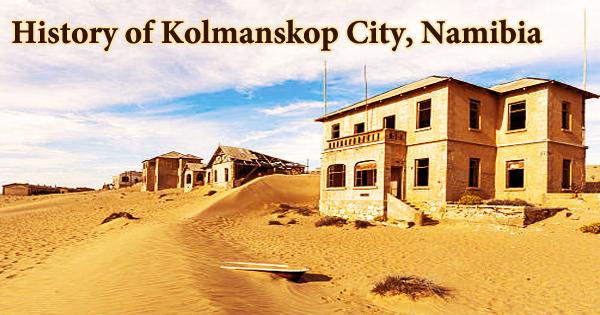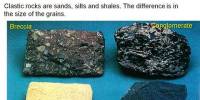Kolmanskop (Afrikaans for “Coleman’s head,” German: Kolmannskuppe) is a ghost town in southern Africa’s Namib Desert, in the center of a region known as “the forbidden zone,” with brightly colored wallpaper peeling off the walls and decaying houses now swamped in rolling banks of sand. Kolmanskop was a minor railway station in 1908 when the line between Lüderitz and Keetmanshoop was established, and it is only 15 kilometers east of Lüderitz’s harbor town. It was named after Johnny Coleman, a transport driver who abandoned his ox cart on a tiny hill opposite the village during a sandstorm. The stunning sight of Kolmanskop Ghost Town can be found about 12 kilometers (7.5 miles) west of Luderitz, almost opposite the Luderitz airport. Kolmanskop’s tale is one of enormous richness, prosperity, and rapid decline. It was formerly home to approximately 1200 people, around 700 families.
Zacharias Lewala, a railway worker, discovered a gleaming stone in 1908 and presented it to August Stauch, the senior railway foreman. Stauch had been assigned to the Grasplatz station with the mission of keeping the railway line clear of sand. He was a hobby mineralogist who had instructed his employees to bring him any unusual stones they came across. He assumed the Lewala find was a diamond right away, which was later verified after the stone was examined by his friend and eventual partner, mining engineer Söhnke Nissen. Stauch and Nissen did not announce their discovery from the rooftops, instead of quitting their professions and securing rights to 75 square kilometers of land at Kolmanskop. They were able to continue their search for diamonds with success.

Hordes of prospectors poured on the area soon after. By 1912, a community had risen up, generating a million carats per year, or 11.7 percent of all diamonds produced worldwide. In the parched desert, wealthy Kolmanskop became a well of luxury. A butcher, a baker, a post office, and an ice plant were all present, and freshwater was delivered by rail. Even opera groups from Europe came to perform. There was a sense of craziness in the air. One family kept an ostrich as a pet that scared the other residents and was forced to drive a sleigh during Christmas.
The town, complete with a ballroom, theatre, hospital, casino, school, and bakery, was erected in just over 40 years, processed over 1 000 kilograms (2 204 pounds) of diamonds, and then was abandoned. The residents built the village in the architectural style of a German town, with amenities and institutions such as a hospital, ballroom, power station, school, skittle alley, theatre and sport-hall, casino, ice factory, and the first x-ray station in the southern hemisphere, as well as the first tram in Africa, fueled by the enormous wealth of the first diamond miners. It had a railway link to Lüderitz.
Kolmanskop became a diamond boom town after over 2000 pounds (1000 kilos) of diamonds were sifted from the sands of the Namib desert prior to World War I. Diamond prices, on the other hand, plummeted during the conflict. Furthermore, larger diamonds were later discovered in Oranjemund, south of Kolmanskop. People grabbed the costly stones and ran after them. The settlement was completely deserted by 1956. Kolmanskop’s prospectors were getting wealthy overnight by selecting diamonds from the desert floor, but German officials wanted more control over the enormous wealth. They retaliated by designating a Sperrgebiet, or restricted zone, in Namibia, prohibiting ordinary people from entering and reserving prospecting rights for a single, Berlin-based corporation.
Tribespeople displaced by the zone’s construction were frequently employed as diamond mine laborers, living in tight, barracks-like complexes for months at a time. A visit to Kolmanskop gives you an unnerving sense of how the desert quietly but steadily reclaims all that has been erected there. The sand seeps into every room, breaking down and absorbing bricks, metal, and plaster, creeping over floors and through entrances as if it were a liquid. As a result, there is a wonderful historical site as well as a fantastic photographic location.

The discovery in 1928 of the richest diamond-bearing resources ever known on the beach terraces 270 km south of Kolmanskop, near the Orange River, hastened the town’s decline decades earlier. Many residents of the town left their houses and belongings behind to join the rush to the south. Rather than more laborious mining, the fresh diamond discovery needed only scouting the beaches. The settlement was left to its own ways, and the desert reclaimed the land it had previously lost.
Between 1956 and 1960, Kolmanskop’s last occupants left. The sand dunes that previously rolled over Lewala’s railway tracks have now broken through its doors and porches, filling the rooms with smooth banks of sand. Ghost Town Tours, a local private firm, was awarded the license to administer Kolmanskop as a tourist attraction in 2002, busing people into the restricted zone to explore and photograph the sand-covered remains. Every year, up to 35,000 people visit the monument, bringing money to Lüderitz, a nearby seaside town.
The town had the highest per capita riches in the world, and its residents mined 12% of the world’s diamonds. In reality, five million carats of diamonds were removed during the first six years of mining. Kolmanskop had the first tram in Africa, as well as the first X-Ray machine in the southern hemisphere, thanks to its wealth. The desert sands are recovering this once-thriving town, and the arid climate is maintaining the area’s typical Edwardian architecture. Kolmanskop is increasingly popular with photographers for its settings of the desert sands reclaiming this once-thriving town.
Visitors can either join a guided tour of the ghost town or go exploring on their own. Spend some time wandering through knee-high sand learning about the lives of the miners and their families. Learn about the town’s government and how each family was given a daily allotment of amenities such as ice and soda water, which were brought to each home by tram. Kolmanskop is an unforgettable experience and a must-see for anybody visiting southern Namibia. Today, engaging and instructive guided tours are available in English, German, and Afrikaans. From Monday through Saturday, tours begin at 9:30 a.m. and 11:00 a.m. On Sundays and holidays, there is just one trip available, which departs at 10:00 a.m.
















